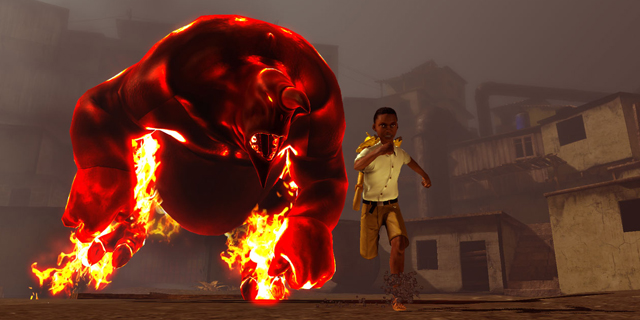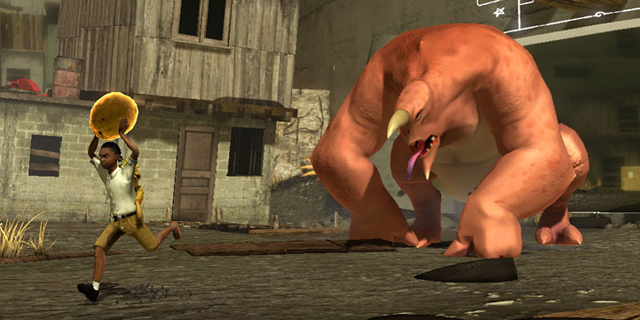
Video games allow for many different stories through multiple perspectives. Through games, players can experience a multitude of different narratives and, not only that, interact with said narratives. When you attempt to tell a very personal story and create a game around that story, things get trickier. You need to find a way to make that story personal to all players, even if they never went through those experiences themselves. This is where Papo & Yo comes in. It tells the story of a young boy struggling to escape his difficult life through fantasy.
The game stars Quico, who runs away from his father into a fantasy world he creates that protects him from reality. He is aided by his robot, Lula, and a mysterious girl who attempts to help him cure a creature simply known as Monster from a horrible addiction. The story is relatively simple, but it covers a lot of thematic ground, including loss, familial ties and, as mentioned, addiction. Some elements are heavy-handed at times, but the story is effective and, by the end, you’ll see how Quico grows as a character. It’s a fascinating tale that left me with a lot to think about.

The story is weaved together brilliantly with the gameplay. As you explore this South American village cobbled together by Quico’s imagination you will often find something new that reflects Quico’s real life and the reality he is attempting to escape. Your main goal is to guide Monster to a place that will cure him of his addictions, but in the process you are tasked with learning his habits and using them to solve puzzles. For example, you can guide Monster using coconuts, which give you some element of control over the creature. Early on, most of the puzzles will involve you hitting switches, leading Monster around with coconuts, and finding a way to the next area.
Soon enough, frogs are introduced, which you quickly learn that Monster loves even more than coconuts. When the beast eats a frog, he becomes enraged and attacks Quico. At this point you must give him a special fruit that will calm him down in order to continue your journey. As the game progresses, you’ll find you run into many sections involving frogs and you’ll have to learn to keep Monster away from them as you attempt to solve the next puzzle. These are some of the most satisfying puzzles in the game, as they involve some quick reflexes as well as fast thinking in order to advance.

The puzzles are never particularly tough, but they offer enough challenge and are usually rewarding. However, some sections tend to drag on too long, making them feel a lot like a chore. There is one particular puzzle that is set up in a clever fashion, but you will eventually reach an unavoidable stopping point that will make you start the entire section all over again. It’s not a difficult puzzle, but a tedious one, and there are a small handful of them that attempt to try something new while dragging on too long and becoming dull in the process.
The majority of the puzzles are solid though, allowing for you to experiment with both Monster and also the different environmental aspects. In most areas, you’ll have the ability to push or pull switches that morph the buildings into staircases or passageways to allow you to progress. Sometimes you’ll to pick up boxes that move entire houses in order to create a bridge, other times you’ll have to turn keys that allow houses to move in particular patterns in order to continue. The environmental puzzles are both visually interesting and provide you with a fantastic look inside of Quico’s head. On top of that, each area has boxes that provide you with hints that don’t give away the puzzle entirely, but give you enough of a clue on how to proceed.
Papo & Yo is a very bizarre, but often thought-provoking, experience. It may frustrate some people with its themes or gameplay elements and it’s not a particularly lengthy game, but everything here is intelligently designed and has a significant purpose. If you’re looking for a downloadable title that’s just a little different from the norm, I highly recommend this imaginative adventure.
Pros: Thought-provoking story, excellent blend of reality and fantasy, rewarding puzzles
Cons: Some heavy-handed themes, certain puzzles drag on a little too long



















